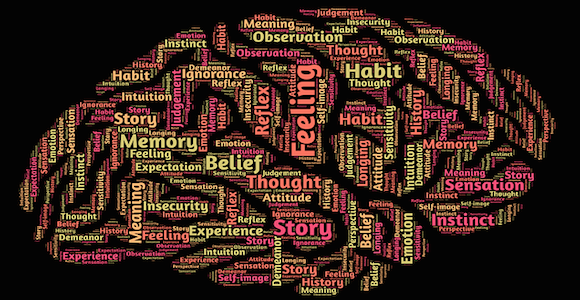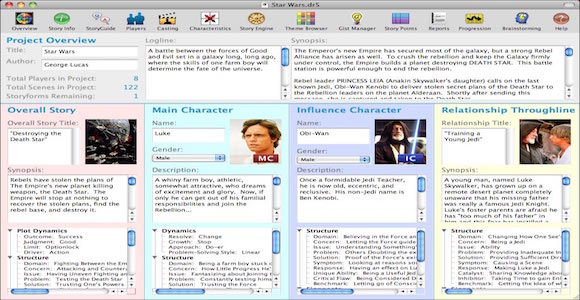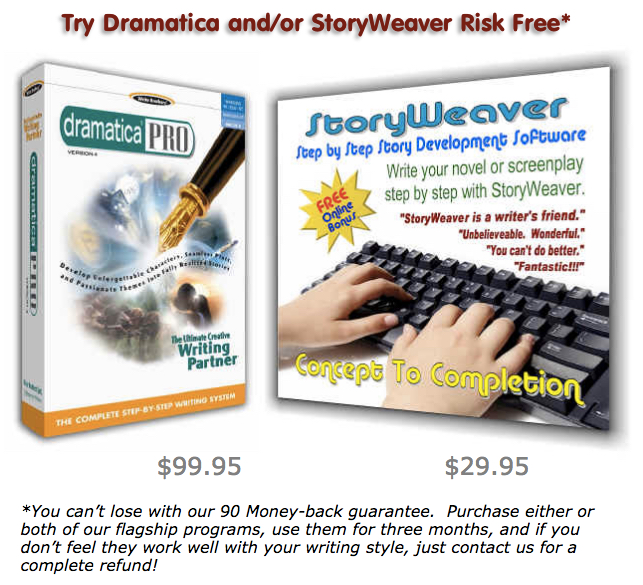A writer in the Ukraine recently wrote me with some questions about the Dramatica theory of narrative structure. First, his questions (indented) and then my answers below each.
Hello!
I’m a big “Dramatica” fan from Ukraine!
Recently I was struggling with understanding some “Dramatica” aspects and especially with translating “Dramatica Dictionary”.
Can you, please, help me? Unfortunately, I haven’t found answers to my questions on your web-site.
Hello to the Ukraine!
Nice to meet you.
Here are some answers to your questions. I’ve put my answers right below each question for easy reference:
1. I agree, that we need Overall Story as bird’s eye view, Main Character Storyline to get to know more about MC, to sympathize and even empathize with him, to see the Story through his eyes nd of course we need MC/IC Storyline to see the battle between two alternate Approaches and Worldviews.
But I can’t understand one thing – why do we need separate IC Storyline? I thought we are interested in IC as long (and as much) as he has direct connection and influence on MC. Yes, we need Impact Character to show MC an alternative way, but having separate IC Line – is it so necessary?
Here are some thoughts on that. First of all, in the mind, the MC represents our sense of self – our identity – “I think therefore I am.” The IC represents the person we might become if we decide to change. And so, in the course of our internal exploration as to whether to retain our identity exactly as it is or to alter it in regard to a particular issue represented by the IC we need to know as much about the IC as we can, in order to make our best educated guess as to whether to stick to our guns or alter our outlook.
Also, the four throughlines represent I (mc), You (ic), we (mc vs. ic) and They (OS). We need all four points of view to understand the environment in which we make our decisions.
2. If we have a Story where there are Main Character and Protagonist (separate characters) – MC goes through a mental emotional journey and decides: he will Change or remain Steadfast. But does Protagonist go through such inner journey or he just goes from Event to Event in a Story (goes only through Outer Journey)? Protagonist doesn’t need to choose between Change and Steadfastness, right?
Correct. Protagonist is only concerned with achieving the goal, though he or she may have very personal and passionate reasons for doing so. But, they are not internally conflicted and do not question their chosen point of view on the matter.
3. When we separate Main Character from Protagonist – does Main Character still have a Goal? Or the main Story Goal is only in hands of Protagonist?
The MC still has a personal goal – it is the kind of angst or anguish they are trying to overcome. The MC’s Concern and Issue and Problem give us some indications as to the nature of that angst. But, keep in mind that the MC, if not the protagonist, must be one of the other characters. If you are using archetypes, the MC could be any of the other 7 archetypes. This is important because the MC’s choice to change or remain steadfast is the lynchpin between the personal issue and story goal that the protagonist is after. The way the MC chooses will determine if the Protagonist finds success or failure, even if the MC is not directly involved in that effort.
4. In the Story Climax there is a battle between Protagonist and Antagonist. But when we have separate Main Character – should he also be involved in this battle? Or he has his own – battle between him and Impact Character?
You suspect correctly, the MC will have a battle of morals or outlooks with the IC in the climax. BUT because the MC will also be one of the objective characters, in that role the “player” that is both MC and an objective character may be involved with the Protagonist in the battle with the Antagonist.
5. If we have a Story with separate Protagonist character and Main Character and also have Complex characters with swapped characteristics like in “Wizard of Oz” – is there a possibility, that Protagonist and Main Character would seem like cardboard cutouts in comparison? Can we accidentally make our supporting character More Interesting than our Main Character or Protagonist? The Only way we can make Main Character complex – is to combine him with Protagonist? The Only way we can make Protagonist complex – is to combine him with Main Character?
Well, any characters can swap characteristics, so if you want a complex “player” then assign the role of MC to a complex objective character. Still, consider that the MC gets a whole class by himself and so does the IC. Also, the MC/IC conflict gets a whole class. But the OS only gets one class and that is where all the objective characters live. So, just by the set-up, stories are designed to give far more exploration to the MC, IC, and their relationship than we find in the OS. You’ll find that this depth of personal, internal exploration makes the MC plenty complex, no matter if their objective player role is archetypal or complex.
6. What came first: Action or Decision? For me it’s really hard to judge. It’s like asking “What came first: Chicken or Egg?”. They are so interconnected. I thought that what if the answer is hiding in Inciting Incident – what Event pushes the Story Forward? If we answer this – we’ll know: Action or Decision, right?
That’s pretty spot on. But, you’ll find that the inciting incident of Action or Decision keeps repeating itself throughout the story. In other words, the inciting incident (action or decision) will occur prompting a response of the remaining item. For example, if an earthquake happens, it prompts decisions about what to do next. If a princess DECIDES to marry someone by the end of the week, everyone springs into action to win her hand. But, once the inciting incident has been dealt with, immediate potential is neutralized. But then, a new inciting incident will crop up requiring a new response. In this manner, .the “driver” will always be the same, throughout the story – in other words, the causality between action and decision is maintained.
The other key point is that whatever the driver is at the beginning that sets things off in a tizzy (action or decision), the plot will be brought to a conclusion by the same driver as the inciting incident. So, action driven stories will end through an action taken at the end that stops the domino effect of the causality. Similarly, decision driven stories will end through a decision that ends that causality.
But that’s just my assumption. For example, first scene in movie “Armageddon” (1997) shows that Meteor “Shower” destroys satellite = Action. Then they are talking about it and trying to develop a plan for rescuing Earth = Decision. Then they arrive to the oil derrick, train men to be an astronauts = Action and so on. So, maybe, in this movie Action is primary.
You pretty much have it. Even though the Bruce Willis character “decides” to sacrifice his life by setting off the bomb, it is the action of the bomb exploding that ends the causal runaway domino effect.
In detective story (like Colombo, Poirot, Sherlock) first we see the Murder = Action and then we see Investigation = Decision.
Yes. And it is an action that is required at the end as well.
In “Ocean’s Eleven” during the whole movie they are trying to develop a plan of the robbery – so it’s Decision Story? But there are plenty of Action (actually performing what they planned).
Yes – keep in mind that the choice of action or decision only determines the causal order of what drives the story. How MUCH of each is in a story is completely up to you and your storytelling. So, a story that begins with a decision, such as The Godfather, can have a tremendous amount of action in it but it ends in the decision to accept Michael as the new Don.
Then what are Decision-movies? Maybe “12 Angry Men”? The whole movie is a Decision-making process. But Inciting Incident was the Murder – Action again.
Well, we never see the murder in 12 Angry Men. It has already happened in the back story. The story begins with the charge to come to a decision. Still, you have to be careful. A story with a decision as the goal does not necessarily mean that it begins and ends with a decision. You really have to look at the back and forth alternation of decision and action to see which one triggers a sequence and which one wraps it up: which creates a potential and which neutralizes that potential.
Yes, I remember that when deciding A or D we don’t need to look at how much A or D there are in a Story.
Indeed. In fact you not only don’t need to look at that, you shouldn’t.
But what is the best, quick and accurate way to identify A or D then?
Look for the moments when a story seems like all the forward momentum has been halted or all the potential has been resolved or all the momentary frenzy has been satisfied. What satisfied it – an action or decision? And what throws another monkey wrench in the story forcing the characters to respond – an action or a decision?
7. Can the Contagonist slow down the Protagonist by accident, can C even not know that he’s doing it? Or he should always be aware about his function and be consciously willing to slow down the Protagonist?
Objective characters, like the protagonist, antagonist and contagonist, are defined by their function in the story. They are defined about how the “work,” not by their opinion of themselves. For example, you could have someone who prides himself on being logical but is actually making all his decisions based on passion. This would be the Emotion archetype, not the Reason archetype for though he things of himself as Reason, his actual function is as passion.
Objective character are objective because we seen them from an objective point of view, like a general on a hill watching a battle. You identify them by their function in the story, not by their awareness of non-awareness of that function.
8. Who can be an Impact Character in a Story:
– Love Interest?
– Sidekick?
– Guardian?
– Contagonist?
All of the above. Any of the Objective Characters can be the IC. Objective characters are identified by role, IC (and MC) are identified by point of view. You can attach a point of view to any of the Objective charactrs.
Seems like each of then can be IC.
Yep.
9. What is the difference between Preconditions and Prerequisites? What are real-life examples (or from movies)? Is it like: if I want to become a student of Oxford, for example, I need to know English not lower than a certain level (this is Precondition). And for this I need to take some necessary steps (Prerequisites) like watching more movies without translation, engage with English tutor or even living in UK for some time to listen to the native speakers. Is my understanding correct?
Best way to think of it is prerequisites are logistically necessary to advance the effort toward the goal. But preconditions are only necessary because someone insists those things are added on. For example, to meet one of the requirements of a goal, the protagonist needs a boat to get across a river. There’s only on person who has a boat and he will let the protagonist use it if the protagonist will take his daughter along. So, the boat is the prerequisite, the daughter is the precondition.
10. What is the difference between Inaction and Protection? It’s the same for me. What real-life or movie example illustrates these terms?
Protection can be like building up defenses or standing between danger and someone else or fighting to keep harm from coming to something or someone. Inaction is not doing anything at all. But, sometimes, just standing by, as in passive resistance, can be a tool for change for it causes forces to change directions to go around you into a new course.
11. What is the difference between Proven and Unproven? It also seems the same for me. Is it just shifted emphasis? Like first i concentrate on what is proven and make my assumptions and decisions based on it. But then I look at clues and shady relationships that are still unproven and try to find evidence to prove they really exist.
Proven and unproven are ways of evaluating. Those focusing on Proven seek to build an understanding based on what is actually known, leaving out anything that is not yet certain. Those focusing on Unproven seek to widen consideration to what might be since it has not yet been ruled out.
“We have proven he was in the same city as each of the three murders at the same time they were committed.” “Sure, and so were 10,000 other people. What you haven’t proven is why he was there.”
Sorry for long letter. I just want to figure out “Dramatica” and, hopefully, successfully use it to make full Stories.
No problem. Always happy to help a seeker.
Thank you for your time and can’t wait to read answers)))
Enjoy!
Melanie
Storymind





